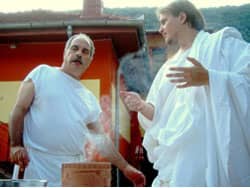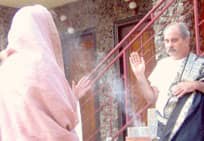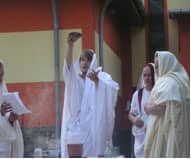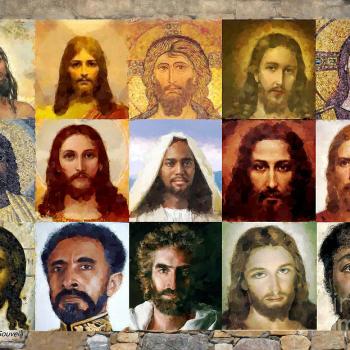Conventus Dacia MMDCCLXI
Baiae Herculane, Romania
 August 2008 was the first occasion when two Consuls of Nova Roma from different continents, one from North America and one from Europe, met one another while in office. It was also the first year when Pontifices from different countries held a conference and celebrated rituals together. This event came after the Consuls and Pontifices M. Horatius and T. Sabinus had for the first time in Nova Roma's history invited other organizations of the Religio Romana in joint religious celebrations.
August 2008 was the first occasion when two Consuls of Nova Roma from different continents, one from North America and one from Europe, met one another while in office. It was also the first year when Pontifices from different countries held a conference and celebrated rituals together. This event came after the Consuls and Pontifices M. Horatius and T. Sabinus had for the first time in Nova Roma's history invited other organizations of the Religio Romana in joint religious celebrations.
But not all celebrations that year were happy occasions.
 In May 2008 Nova Roma saw its first member to die while involved in a war. C. Popillius Strabo died in Iraq while serving in the U.S. Army. He received a military funeral in his hometown. At the request of his widow, his funeral recognized him as a cultor Deorum Romani and member of Nova Roma. Pont. Max. Horatius conducted additional ceremonies, inviting the genius of C. Popillius to return to his home, and called upon the sacred Lares to guide him on to the Blessed Isles.
In May 2008 Nova Roma saw its first member to die while involved in a war. C. Popillius Strabo died in Iraq while serving in the U.S. Army. He received a military funeral in his hometown. At the request of his widow, his funeral recognized him as a cultor Deorum Romani and member of Nova Roma. Pont. Max. Horatius conducted additional ceremonies, inviting the genius of C. Popillius to return to his home, and called upon the sacred Lares to guide him on to the Blessed Isles.
 Eastern Europe has become an exciting region for the Religio Romana. This region also provides an example of how the tradition wishes to develop in the future even as we look to the past.
Eastern Europe has become an exciting region for the Religio Romana. This region also provides an example of how the tradition wishes to develop in the future even as we look to the past.
Since the end of the Pax Deorum of Rome in the 4th century with the attempt of Theodosius to prohibit even private worship of the Gods, the religio Romana continued with individuals, within important families, and in some communities throughout Western Europe, although under circumstances where these cultores became increasingly isolated from one another. Attempts were made to revive the Religio Romana in Italy with Pomponio Leto and the Academy of Rome (dissolved by Pope Paul II in 1468 and its members imprisoned and persecuted). Other revivals were attempted in the 18th and 19th centuries as Italy pursued national unification. Elsewhere in Western Europe and in the Americas other individuals and small isolated societies developed of cultores Deorum Romani.
A major development came with the Risorgimento of the late 19th century -- the discoveries of archaeologist Giacomo Boni, the re-introduction of the ludi Troiae in Rome, the Ara Graminea on the Palatine Hill, and other events that celebrate Roma antiqua. Revival and reconstruction of a Religio Romana as a state religion, or at least as a religion of the City of Rome, was advocated in such publications as the Salamander by A. Reghini (1914), by A. Armento in ATANOR (1924), Ignis (1925), and the Western Tradition essay by A. Reghini (1928), his essay Pagan Imperialism, and a book by Julius Evola with the same name (1929).
These advocates for a modern reconstruction of a Religio Romana were both encouraged by the rise of fascism and reacted against Mussolini's involvement with the religion and with his accord with the papacy. After World War II, interest in the Religio Romana in Italy remained, for the most part, connected with right-wing political movements like the Groups of the Dioscuri. Renato del Ponte became influential with his magazine Arthos (1972), his books Italic Gods and Myths (1985) and The Religions of the Romans (1993). Another influential person on Italian practitioners was Salvatore Ruta, coming from the Dioscuri of Messina, who began the Arx Group (1984) and began publishing The Citadel magazine that supports the Movimento Tradizionale Romano (MTR).
In Italy today there are three main divisions of the Religio Romana. The MTR emerged in the mid-1980s from Salvatore Ruta of Messina (Arx), Renato del Ponte in Genoa (Arthos), and Roberto Incardona of Palermo. The MTR is a politico-cultural association that practices reconstructed Roman rituals with little interest in the religious and metaphysical aspects of the Religio Romana tradition. Its interest in the Religio Romana remains primarily political rather than religious.




